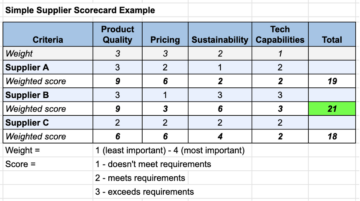
Just-in-time inventory management has been around for roughly half a century. In that time, however, the original concept has become muddied, causing some companies to face precisely the supply chain issues that JIT was conceived to solve. This was especially true during the supply chain crises of the past three years.
It’s time to reassess. Fifty years offers plenty of time and data to evaluate how the system has performed, how it’s changed, and specifically how it can be merged with Industry 4.0 principles to create maximum efficiencies.
The original JIT model was said to be perfected by Toyota as part of its Toyota Production System (TPS), although the company may have just been one of the first to apply the concept to manufacturing. Whether Toyota deserves the credit or not, it successfully applied it. Given the automaker’s meteoric success over the past half-century, it can’t be denied that JIT can be an incredibly effective system.
The concept is a simple one. Maintain just enough inventory onsite to keep the manufacturing supply chain humming for a given period of time. If you need more, recognize it in advance and order from a local supplier close to your company. This lessens the time it takes to get parts to you, while massively reducing the cost of shipping. A side benefit is that local suppliers are more easily overseen. You can even visit them, should you ever need to, enhancing your ability to maintain quality control. Finally, and most importantly, JIT reduces the need to warehouse inventory onsite, a hidden cost not usually considered when it comes to piece-part pricing from offshore manufacturers.
Has JIT Become Irrelevant?
Over time, however, the notion of having nearby suppliers providing “just-in-time” parts became something of a quaint relic. As manufacturing globalized, the JIT methodology did as well, meaning that it became more typical to order parts in large quantities from abroad, then warehouse material to ensure it’s available when needed. On the face of it, that move seemed smart, as it’s hard to beat piece-part pricing from certain foreign countries. In truth, however, it invites a litany of hidden costs to contend with, as entire supply chain organizations are needed to manage and move materials around the world.
There are also long-term costs incurred when your company can’t iterate quickly because of extended lead-times and excess inventory in the supply chain. In today’s consumer culture, there’s an expectation that products don’t come in one flavor or style. Instead, consumers are looking for choice, uniqueness and customization. Moreover, they want inventiveness and cutting-edge elements, especially advanced technology. If your parts speak to last year’s models and concepts more than this (or next) year’s, you may lose customers.
Iteration across an ocean is a painfully slow process. It takes time to get parts produced and transported for inclusion in the final product, and even longer when they encounter international shipping and customs delays. They can also be affected by concerns such a pandemic, geopolitical upheaval, or even ships blocking international shipping lanes. These one-time events seem to be happening with greater frequency, with pundits suggesting that instability is here to stay. And of course, there’s the matter of tariffs. So what can lessen these risks? A return to JIT sensibility, tied to Industry 4.0 principles.
The Local Sourcing Model
JIT suggests that working with local or regional — rather than global — suppliers can help simplify and improve the supply chain. Using fewer transfers to produce and deliver parts increases the chance that you’ll receive them when they’re needed.
Imagine a not-terribly-unusual scenario. Your company is ready to prototype a molded part design. You send the computer-assisted design (CAD) model abroad and wait, sometimes for months, to get the part back. Issues crop up and you need to change the tool; it’s not rare that molds require multiple iterations. But waiting months to finalize one part design can set you back, and suddenly you’re in your product’s next model year and unable to deliver on your promised timeline. Using JIT sensibility instead, you would send the model to a regional manufacturer that can turn it around in a fraction of the time.
In response to recent disruptions, supply chain leaders are changing their strategies. A recent McKinsey survey revealed that 44% of respondents have moved to regional sourcing in the last year, and more than half expect that trend to continue.
The revitalization of the old JIT philosophy comes at a time when the many benefits of a regional supply chain can be paired with technologies made possible by the Fourth Industrial Revolution, to create a sourcing strategy rich in efficiency and agility.
For example, a regional manufacturer that adheres to Industry 4.0 principles puts your CAD model through the manufacturing process as a digital twin, a virtual version that’s created and evaluated for manufacturability. Once changes are made to improve moldability, physical molds are cut, parts are made, and you have them in your hand in days instead of months.
With Industry 4.0, we talk about on-demand manufacturing, one of the foundational elements of JIT. Like JIT, it says that rather than stocking excessive quantities of parts, you only order what will be needed for a given period of time. At the start, it’s a process of informed trial and error, but the ultimate result is that you don’t have to keep an entire warehouse filled with parts and endure the attendant storage costs. It also means that you reduce waste should you need to change your product, necessitating version 2.0 parts. You can make small changes to existing part designs, or even iterate new ones, without worrying about the need to reduce inventory of existing parts first, or worse, just throwing them away. This speaks to another Industry 4.0 principle: sustainability and environmental sensitivity.
Digital manufacturers have discovered the benefits of merging their regional facilities with a global strategy, offering up the best of all worlds to their customers. Some take it a step further and work in partnership with a specialized network of approved manufacturers, offering all the benefits of a local JIT model with a comprehensive international sensibility that maintains high levels of speed, reliability, and quality. This may prove to be the wave of the future, and it’s cresting right now.
Bernadine Henderson is director of global procurement and strategic sourcing at Protolabs.
- SEO Powered Content & PR Distribution. Get Amplified Today.
- Platoblockchain. Web3 Metaverse Intelligence. Knowledge Amplified. Access Here.
- Source: https://www.supplychainbrain.com/blogs/1-think-tank/post/36382-jit-and-industry-40-the-future-of-modern-manufacturing
- a
- ability
- About
- across
- advance
- advanced
- Advanced Technology
- All
- Although
- and
- Another
- applied
- Apply
- approved
- around
- available
- back
- because
- become
- benefit
- benefits
- BEST
- blocking
- CAD
- causing
- Century
- certain
- chain
- Chance
- change
- Changes
- changing
- choice
- Close
- come
- Companies
- company
- comprehensive
- conceived
- concept
- concepts
- Concerns
- considered
- consumer
- Consumers
- continue
- control
- Cost
- Costs
- countries
- course
- create
- created
- credit
- crop
- Culture
- Customers
- customization
- customs
- Cut
- cutting-edge
- data
- Days
- delays
- deliver
- deserves
- Design
- designs
- DID
- digital
- digital twin
- Director
- discovered
- disruptions
- Dont
- during
- easily
- Effective
- efficiencies
- efficiency
- elements
- encounter
- enhancing
- enough
- ensure
- Entire
- environmental
- error
- especially
- evaluate
- evaluated
- Even
- events
- EVER
- example
- existing
- expect
- expectation
- Face
- fifty years
- filled
- final
- Finally
- First
- foreign
- Fourth
- fourth industrial revolution
- fraction
- Frequency
- from
- further
- future
- geopolitical
- get
- given
- Global
- greater
- Half
- Hard
- having
- help
- here
- Hidden
- High
- How
- However
- HTTPS
- improve
- in
- inclusion
- Increases
- incredibly
- industrial
- Industrial Revolution
- industry
- industry 4.0
- informed
- instability
- instead
- International
- inventory
- Inventory Management
- issues
- IT
- iterations
- JIT
- Keep
- large
- Last
- Last Year
- leaders
- levels
- local
- long-term
- longer
- looking
- lose
- made
- maintain
- maintains
- make
- manage
- management
- Manufacturer
- Manufacturers
- manufacturing
- many
- massively
- material
- materials
- Matter
- maximum
- McKinsey
- meaning
- means
- merging
- meteoric
- Methodology
- model
- models
- Modern
- molds
- months
- more
- most
- move
- multiple
- Need
- needed
- network
- New
- next
- Notion
- ocean
- offering
- Offers
- Old
- ONE
- order
- organizations
- original
- paired
- pandemic
- part
- Partnership
- parts
- past
- period
- philosophy
- physical
- plato
- Plato Data Intelligence
- PlatoData
- Plenty
- possible
- precisely
- pricing
- principle
- principles
- process
- produce
- Produced
- Product
- Production
- Products
- promised
- prototype
- Prove
- providing
- Puts
- quality
- quickly
- RARE
- ready
- receive
- recent
- recognize
- reduce
- reduces
- reducing
- regional
- reliability
- require
- response
- result
- return
- Revealed
- Revolution
- Rich
- risks
- roughly
- Said
- seemed
- Sensitivity
- set
- Shipping
- ships
- should
- Simple
- simplify
- slow
- small
- smart
- So
- SOLVE
- some
- something
- Sourcing
- speak
- Speaks
- specialized
- specifically
- speed
- start
- stay
- Step
- storage
- Strategic
- strategies
- Strategy
- style
- success
- Successfully
- such
- Suggests
- suppliers
- supply
- supply chain
- Sustainability
- system
- Take
- takes
- Talk
- tariffs
- Technologies
- Technology
- The
- The Future
- the world
- their
- three
- Through
- Throwing
- Tied
- time
- timeline
- to
- today’s
- tool
- toyota
- tps
- transfers
- transported
- Trend
- trial
- true
- TURN
- typical
- ultimate
- usually
- version
- Virtual
- wait
- Waiting
- Warehouse
- Waste
- Wave
- What
- whether
- while
- will
- without
- Work
- working
- world
- world’s
- would
- year
- years
- Your
- zephyrnet












